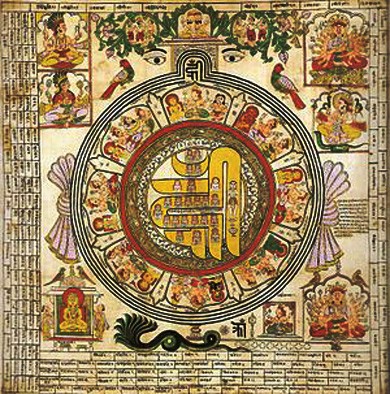
Jainism is one of the oldest living religions of the world. A Jain believes in Jain principles and tries to act by them in everyday life. These principles form the religion called ‘Jainism’. The term Jaina means the devotee of Jinas (Spiritual Victors). Jinas are called so because they have won victory over passions of attachment, aversion, etc. that defile the soul. As a result, they have attained omniscience and supreme bliss. They are enlightened human teachers.These teachers or Tirthankars are not creators or rulers of the world. They are souls, who have attained perfection & thus are pure & divine.
Jainism encourages spiritual development through cultivation of one’s own personal wisdom and reliance on self control through vows. The three jewles of Jainism, namely right vision or view (Samyak Darshana), right knowledge (Samyak Gyana) and right conduct (Samyak Charitra) – provide the path for attaining liberation from the cycles of birth and death. When the soul completely sheds its karmic bonds, it attains divine consciousness.
In Jainism, the essence of religion lies in an intuitive apprehension of the purity of consciousness. According to Jainism, the love of truth is inherent in each self, but it requires spiritual exercise for its manifestation. Once this love of truth is manifested, it will lead the self to liberation sooner or later. The conduct of a person, in the Jain view cannot be isolated from his way of life. For a true Jain, truth and values are inseperable. This is where right knowledge comes in. As Acharya Samantabhadra in his Yuktyanushasanam (Verse 15) says : “Without knowing the real nature of things, all moral distinctions between bondage and liberation, merit and demerit, pleasure and pain will be absurd.”
Jainism believes in the potential divinity of man. Given freedom for development, every individual can attain supreme spiritual progress. Hence, any interference with an individual’s development would lead to spiritual degeneration. Violence is nothing but such an interference with individual freedom, hence, it must be shunned in thought, word and deed.
Jain ethics are directed towards the liberation of the individual. Its end is the spiritualization of all areas of life in order to prepare individuals for the achievement of his ultimate goal. Jainism permits no distinction between the religion (Dharma) and morality because both are concerned with the well-being of the individual. The practice of Dharma enables them to achieve this end. In the words of the well-known Acharya Samantabhadra, “Religion is something which takes the living beings out of the worldly misery and establishes them in the highest bliss.” This interconnection between religion and morality imparts to Jainism its distinctive feature. There are three distinct contributions of Jainism to Indian Culture viz. Equality (Sama), Self-control (Shama) and Dignity of labour (Shrama).
He who loses his soul, loses everything. Self-help and self-reliance constitute the basic motto of Jain religion. According to the Jain religion, ‘Atma’ is the creator of weal and woe : the notion of exploiting others by way of labour does not occur in this system.
Reference
1. Glory of Jainism by Kumarpal Desai










Hindi language me apload karna chahiye.
Thank You for the comment. We are working hard on making the whole site available in hindi.
There are many other articles that are currently available in hindi, you can access them by visiting the following url http://tattvagyan.com/hi
why dont u put up all these articles and blogs at http://www.speakingtree.in
. great site for connecting people in mystic life and dharma…
We’ll consider doing that. Thanks for the suggestion!
The meaning of purvang as per information from other sourses is 84 lakh.
In this article, it is 84 thousand. Which one is correct?